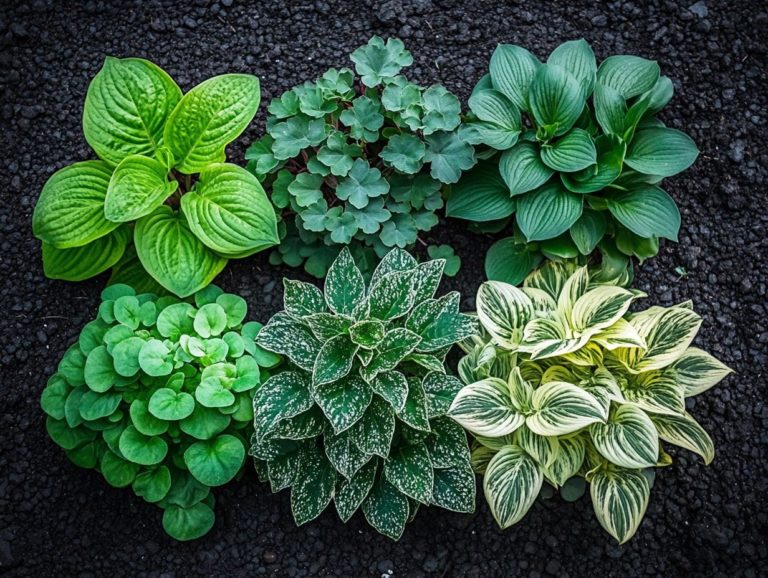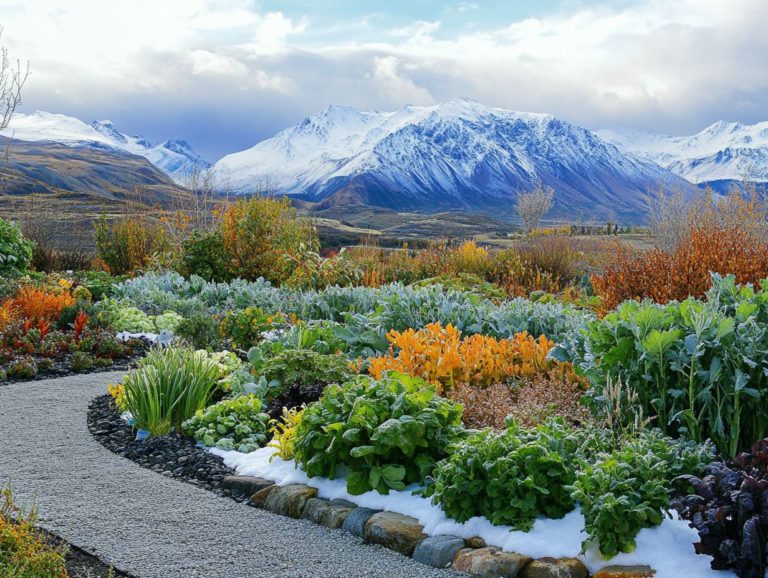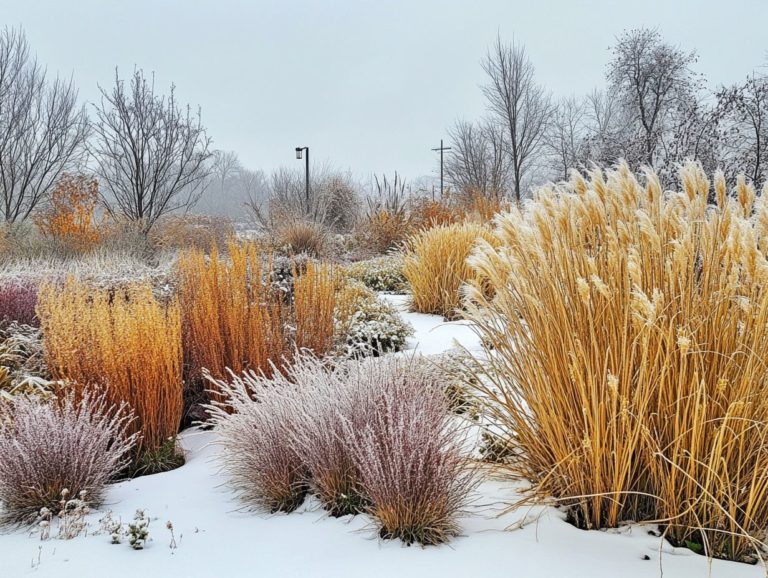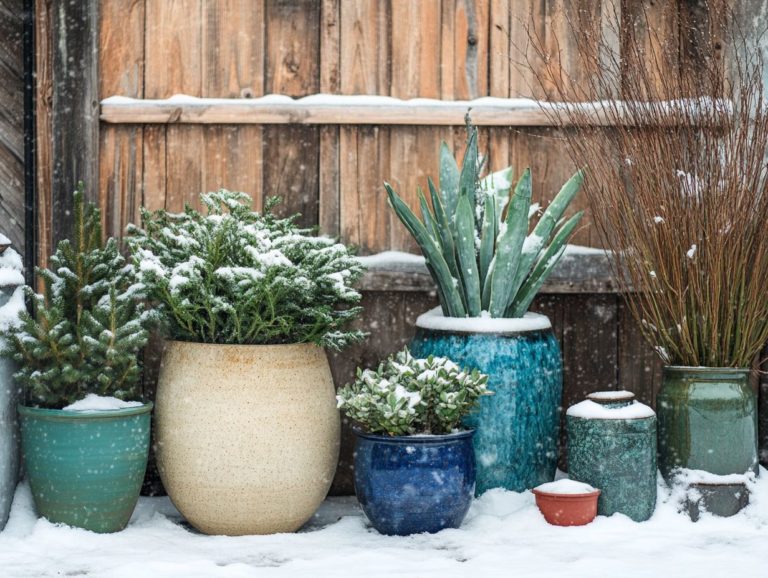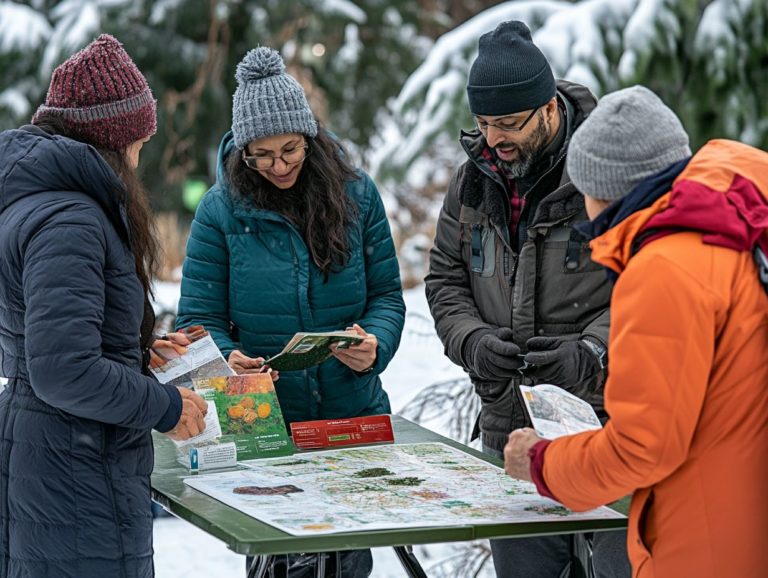Top 10 Low-Maintenance Plants for Cold Climates
Gardening in cold climates may seem daunting, but it doesn t have to feel like a chore.
Explore the top 10 low-maintenance plants that thrive in frigid temperatures and enhance the beauty of your landscape. From resilient succulents to the striking winterberry holly, these plants are ideal for crafting a stunning garden with minimal effort.
You ll discover their benefits, survival strategies, and expert tips for selecting the right ones. This ensures your garden remains vibrant and inviting throughout the year.
Contents
- Key Takeaways:
- 1. Hardy Succulents
- 2. Russian Sage
- 3. Siberian Iris
- 4. Dwarf Korean Lilac
- 5. Creeping Juniper
- 6. Canadian Hemlock
- 7. Winterberry Holly
- 8. Hellebores
- 9. Red Twig Dogwood
- 10. Dwarf Alberta Spruce: A Stunning Choice for Container Gardening
- What Are the Benefits of Having Low-Maintenance Plants for Your Garden?
- How Can These Cold Climate Plants Survive in Frigid Conditions?
- What Are Some Tips for Choosing the Right Low-Maintenance Plants for Your Garden?
- How Can These Cold Climate Plants Enhance the Aesthetics of Your Garden?
- What Are Some Common Mistakes to Avoid When Caring for Cold Climate Plants?
- How Can These Cold Climate Plants Be Used in Landscaping for Your Outdoor Spaces?
- Frequently Asked Questions about Cold Climate Plants
- What Are the Top 10 Low-Maintenance Cold Climate Plants?
- What Makes These Cold Climate Plants Suitable for Harsh Conditions?
- Do Cold Climate Plants Require Special Care During Winter?
- Can These Plants Survive in Extremely Cold Temperatures?
- Do These Plants Produce Any Flowers During Winter?
- Are These Cold Climate Plants Suitable for All Types of Gardens?
Key Takeaways:
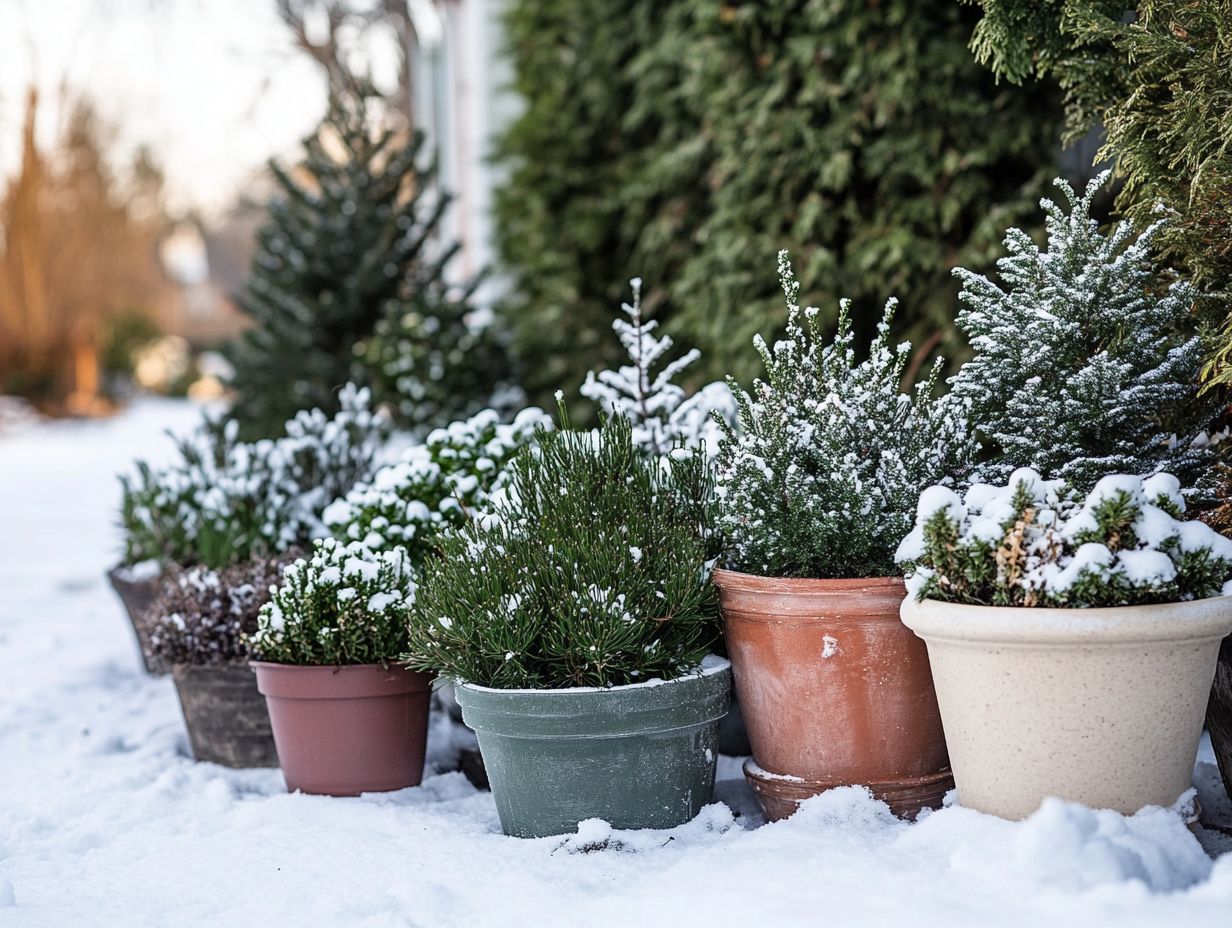
- Low-maintenance plants can thrive in cold climates, making them perfect for busy gardeners.
- Hardy succulents, Russian sage, and Siberian iris are just a few examples of plants that add beauty to a cold climate garden.
- When choosing low-maintenance plants, consider their hardiness, light and water needs, and ability to withstand harsh winter conditions.
1. Hardy Succulents
Hardy succulents are perfect for creating vibrant gardens in colder climates and, for beginners, exploring the top 5 cold-climate plants can provide excellent options. They thrive in winter and require minimal care.
Don t miss out on colorful plants like Sedum and Sempervivum. These resilient beauties can transform your garden!
They grow best in well-drained soil to avoid root rot. Most prefer full sun, but can adapt to part shade.
Their incredible ability to survive harsh winter conditions ensures that you can enjoy their vibrant foliage all year long.
2. Russian Sage
Russian Sage is a stunning perennial plant that dazzles with vibrant purple blooms. It attracts pollinators, making it ideal for wildlife gardening.
This remarkable plant showcases impressive drought tolerance, thriving in dry, sunny areas.
Its aromatic, silvery foliage adds texture and depth to your garden. Once established, it requires minimal care, making it a go-to for busy gardeners.
3. Siberian Iris
Siberian Iris flourishes in well-drained soil and showcases breathtaking spring blooms. It elevates the elegance and color palette of your garden.
This adaptable plant is perfect for any gardener seeking versatility. Prepare the soil with natural materials like compost for enhanced growth.
Light conditions are crucial; Siberian Iris thrives in both full sun and part shade.
4. Dwarf Korean Lilac
The Dwarf Korean Lilac is a charming perennial that requires minimal care while offering fragrant blooms. It s perfect for container gardening.
This compact plant reaches about three to four feet tall, making it excellent for small gardens or as a stunning focal point.
It thrives in well-drained soil and prefers full sun to partial shade, providing versatile growing conditions.
Thanks to its low-maintenance nature, you can enjoy vibrant blooms without constant upkeep. The Dwarf Korean Lilac attracts pollinators, supporting local wildlife while adding charm to your garden.
Start your low-maintenance garden today and watch it flourish, even in the cold!
5. Creeping Juniper
Creeping Juniper is a remarkable cold-hardy perennial that flourishes in both full sun and part shade. It s an ideal choice for your low-maintenance garden, offering ground cover and seasonal allure.
This resilient plant adapts effortlessly to various soil types and conditions. It showcases an impressive ability to endure drought while providing robust protection against soil erosion.
By anchoring the earth with its sprawling roots, it significantly minimizes the risk of runoff and degradation.
In wildlife gardening, this juniper attracts pollinators and serves as a sanctuary for beneficial insects and small creatures. When paired with other native plants, it boosts the variety of plants and animals, fostering a thriving ecosystem.
6. Canadian Hemlock
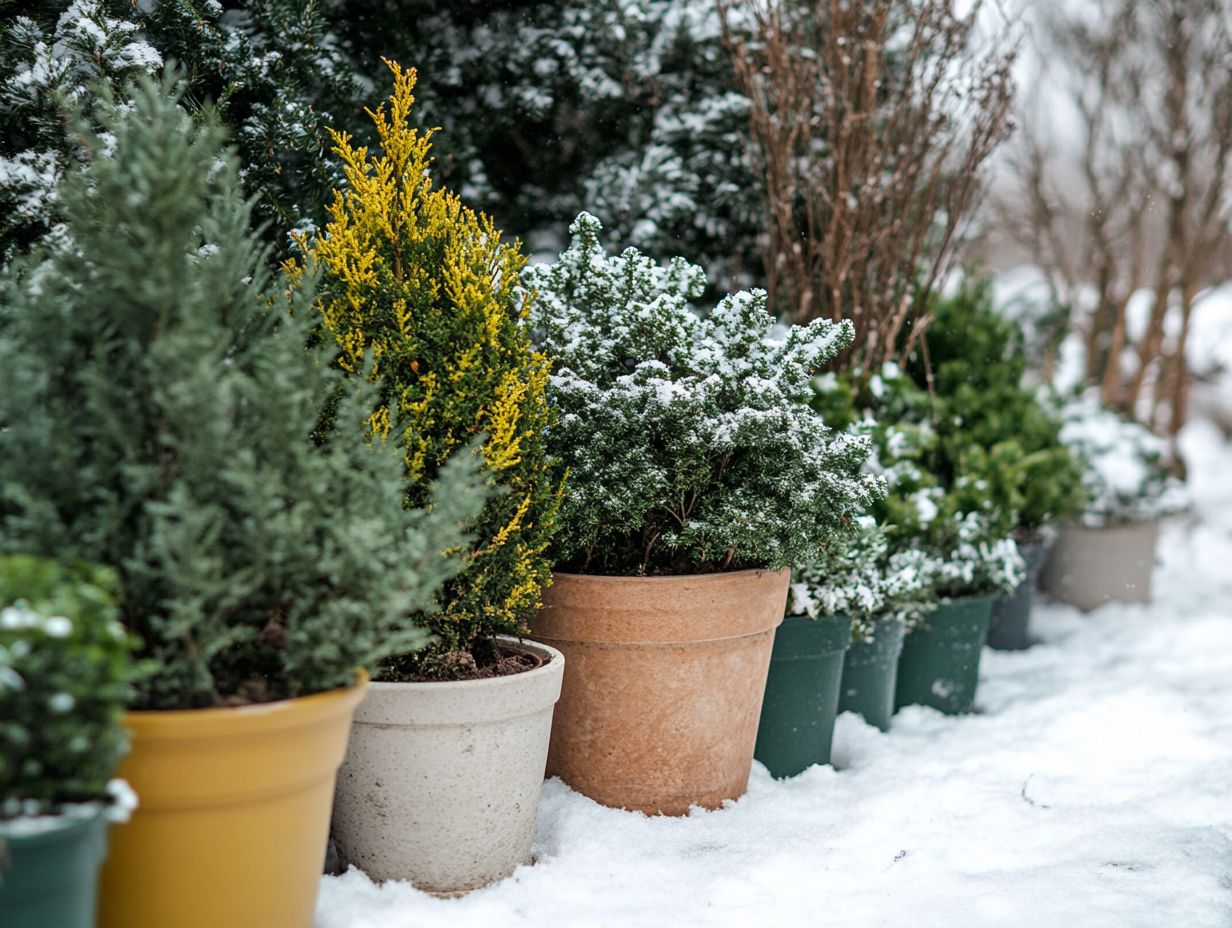
The Canadian Hemlock is a true gem among cold climate plants. It provides year-round greenery and serves as a vital habitat for diverse wildlife, enriching your wildlife gardening efforts.
With its elegant, drooping branches and slender silhouette, this evergreen flourishes in soils that drain well and are slightly acidic. It thrives in partial shade, making it perfect for your shaded garden spaces.
Its lush, dense foliage enhances the visual appeal of your landscape, functioning as a natural privacy screen or windbreak. This plant also plays a crucial role in supporting the variety of plants and animals.
It provides nesting sites and sustenance for birds and various wildlife, promoting a harmonious ecosystem. By welcoming this tree into your landscape, you ll elevate the habitat for local fauna while enjoying its timeless elegance all year round.
7. Winterberry Holly
Winterberry Holly is a striking, cold-hardy plant. Its bright red berries in winter beautify your landscape and attract birds and other wildlife, making it ideal for wildlife gardening!
As the seasons shift, this remarkable plant transitions from lush green foliage in summer to vibrant reds and yellows in fall. This creates a stunning visual display that will have your neighbors asking for gardening tips.
For fruitful berry production, you ll need both male and female plants, so plan accordingly. Choose a sunny spot for planting to help it thrive!
In winter, its bare branches adorned with brilliant berries add a splash of color to the stark landscape. During the warmer months, the blossoms become essential nectar sources, drawing in bees, butterflies, and other pollinators, enhancing the overall ecosystem of your garden.
8. Hellebores
Hellebores, often affectionately known as Christmas Roses, are charming cold-hardy perennials that bloom in early spring. They bring a delightful splash of color and seasonal interest to your part-shade garden.
These resilient beauties thrive in well-drained, rich soil that retains just enough moisture without becoming soggy. Their watering needs are modest, requiring only a deep soak during dry spells.
Beyond their easy care, hellebores impress with an astounding palette of colors, ranging from gentle pastels to deep, vivid hues. They showcase elegant forms, from single to double flowers, allowing for a versatility that complements various plantings.
This unique texture and visual appeal elevate the overall aesthetic of any garden space you create.
9. Red Twig Dogwood
Red Twig Dogwood is a breathtaking cold-hardy perennial that transforms your garden with its striking bright red stems in winter. Not only does this add visual interest, but it also provides essential habitat for wildlife, making it a superb choice for wildlife gardening enthusiasts.
With its bushy and vigorous spreading habit, this shrub excels at controlling erosion while creating a lush backdrop for your other plants. You ll enjoy its vibrant green foliage in spring and summer, which gracefully shifts to stunning hues of red and orange in the fall, revealing those iconic red stems as winter sets in.
If you re aiming for a low-maintenance garden, incorporating this adaptable variety ensures your landscape remains appealing year-round without demanding too much attention. It thrives in various soil types, including sandy, clay, and loamy conditions, making it a versatile option that fits seamlessly into modern landscaping needs.
10. Dwarf Alberta Spruce: A Stunning Choice for Container Gardening
Dwarf Alberta Spruce is a compact, cold-hardy perennial that effortlessly elevates your container garden, infusing it with a touch of elegance while requiring minimal upkeep. You ll love how easy it is to care for!
This charming evergreen likes soil that drains well and is slightly acidic. It flourishes in full sun to partial shade, giving you the flexibility to place it beautifully within various landscapes. Pair it with wildlife-friendly plants, such as vibrant native wildflowers or lush ground covers, to create a visually stunning display and contribute to a thriving ecosystem.
The structured silhouette of this spruce acts as a striking focal point while providing valuable shelter for various bird species. Incorporating it into your landscape transforms your space into a sanctuary that welcomes diverse wildlife, enhancing both its beauty and ecological value.
What Are the Benefits of Having Low-Maintenance Plants for Your Garden?
Having low-maintenance plants in your garden saves you time and effort while opening the door to a rich diversity of shrubs for cold-climate gardens that flourish in various conditions. This choice fosters community engagement through shared gardening experiences and wildlife gardening endeavors.
These plants fit perfectly for eco-conscious individuals, as they require less water and fewer fertilizers, minimizing both maintenance costs and environmental impact. By selecting flora that naturally adapt to your local ecosystem, you contribute to sustainability, enriching the soil and supporting healthier pollinator populations.
Incorporating such plants into your garden can elevate your personal well-being, encouraging outdoor activities and mindfulness. Ultimately, low-maintenance gardening creates a vibrant habitat that nurtures biodiversity, providing refuge for diverse species and promoting a balanced ecosystem making gardening accessible and enjoyable for everyone.
How Can These Cold Climate Plants Survive in Frigid Conditions?
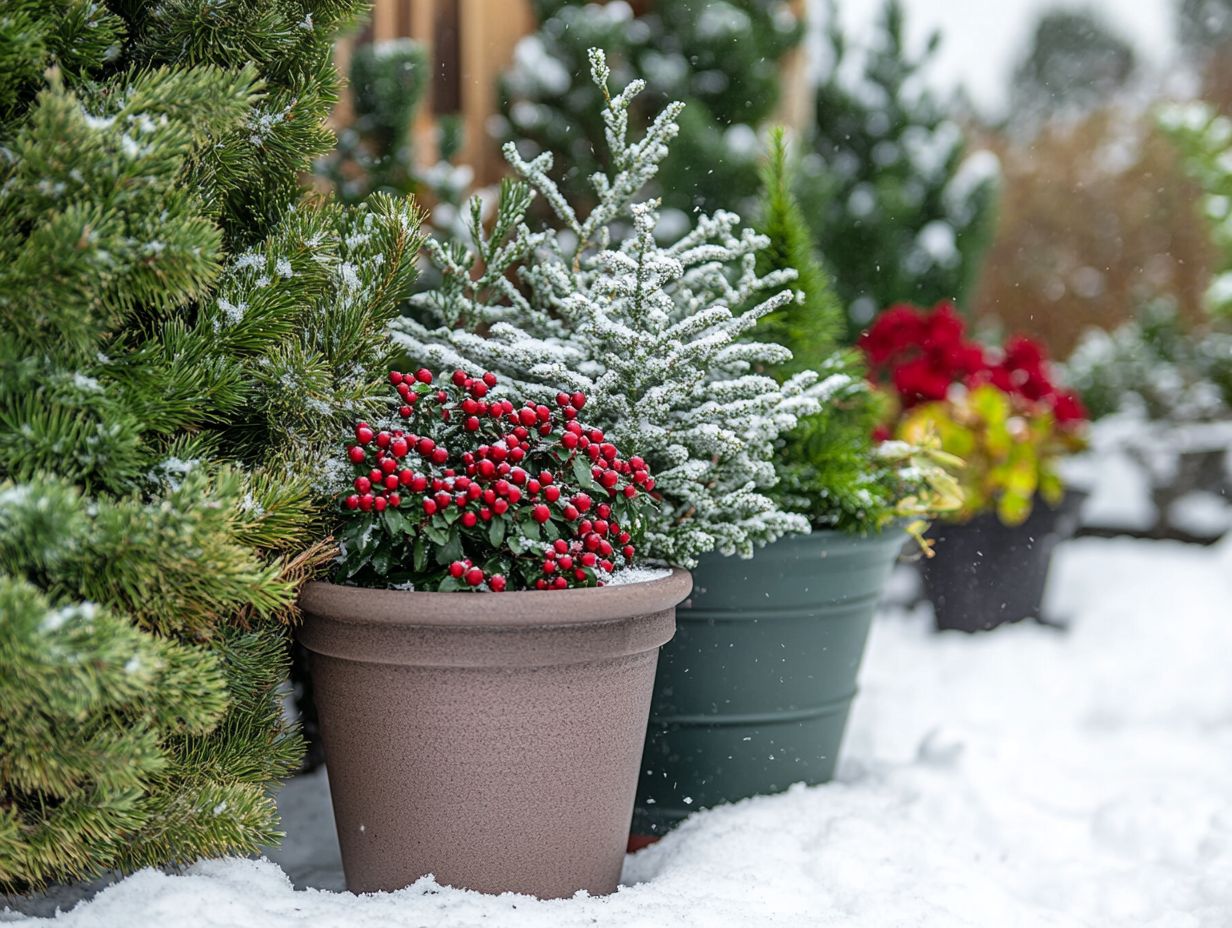
Cold-hardy perennials have a remarkable way of surviving in frigid climates, thanks to their unique adaptations. They develop deep root systems that anchor them through winter’s wrath and possess the resilience to withstand cycles of frost and thaw. For those looking to enhance their gardening efforts, exploring the top 5 planters for cold-climate gardening can ensure their survival even in the most extreme conditions.
During the harshest months, these extraordinary plants enter a state of dormancy, meaning they slow down their growth to save energy. This natural strategy helps them save resources and protects vital tissues from the biting cold.
Take the hellebore and Arctic poppy, for example. They don t just boast stunning blooms in early spring; their robust foliage stands strong against snowfall, adding beauty to gardens even in the depths of winter. Their ability to thrive where others wither showcases nature’s brilliance, allowing you to experience vibrant colors in your garden all year round don t miss out!
Transform your garden today with these resilient choices!
What Are Some Tips for Choosing the Right Low-Maintenance Plants for Your Garden?
Choosing the right low-maintenance plants for your garden requires a bit of thought. You’ll want to consider factors like climate, light exposure, and soil type to ensure that options like pest-resistant plants for cold climates flourish with minimal fuss in your garden or container setups.
To truly maximize your plant selections’ success, it’s essential to assess the plant hardiness zone of your region. This knowledge will guide you in picking plants that can handle local temperatures and seasonal shifts.
Understanding the growth conditions like whether a plant thrives in full sun or prefers part shade will save you from the disappointment of blooms that just won t take off.
It’s equally important to think about how different plants will interact in your garden space. By pairing plants with similar water and nutrient needs and ensuring they won’t overcrowd each other, you re setting the stage for a more harmonious garden ecosystem.
How Can These Cold Climate Plants Enhance the Aesthetics of Your Garden?
Integrating cold-hardy perennials into your garden design can significantly elevate its aesthetics. They introduce a delightful array of colors and textures along with seasonal blooms that not only beautify but also contribute to wildlife gardening efforts.
Strategically placing these plants can create a visually captivating landscape that transforms with each passing season. For instance, consider incorporating purple coneflowers and black-eyed Susans; they bring vibrant summer colors and attract essential pollinators like bees and butterflies.
As fall draws near, ornamental grasses such as fountain grass can add graceful movement and texture while providing habitat for small wildlife. In winter, the remnants of these perennials create stunning visuals, proving that beauty can shine, even in the cold!
This approach ensures your garden remains a dynamic and sustainable environment throughout the year.
What Are Some Common Mistakes to Avoid When Caring for Cold Climate Plants?
Avoid these common mistakes to ensure your garden thrives! When caring for cold-hardy perennials, it s essential to steer clear of overwatering, improper pruning, and overlooking their specific winter needs. Failing to address these factors can lead to lackluster growth and health, even in a low-maintenance garden.
Recognizing that each plant has its own set of requirements is crucial for optimal care. Some perennials thrive on less water during dormancy, while others may struggle with insufficient light exposure.
By dedicating time to research and adapt your care practices like perfecting the timing of your pruning or adjusting soil drainage you can significantly elevate the resilience and beauty of your perennial displays. Regularly observing your plants throughout the seasons also enables timely interventions.
This ensures that these hardy specimens not only survive but truly flourish in the ever-changing climate.
How Can These Cold Climate Plants Be Used in Landscaping for Your Outdoor Spaces?
Using cold-hardy perennials in your landscaping for cold climates allows you to craft a visually stunning and functional outdoor space that demands minimal maintenance. For inspiration, check out the top 10 plants for small cold-climate balconies. Plus, it supports local wildlife while elevating the overall aesthetic of your garden.
By applying thoughtful design principles, you can layer various plant heights to establish depth, placing taller specimens at the back and shorter ones in front. This enhances visibility and creates a dynamic visual flow that captivates the eye.
Utilizing contrasting colors will draw attention and provide vibrant focal points throughout your garden. Seasonal interest is essential; incorporating perennials that bloom at different times ensures your landscape remains captivating all year round.
Successful projects often showcase combinations of purple coneflowers and goldenrod, which thrive in colder environments, delivering striking contrasts and sustained beauty that will leave a lasting impression.
Frequently Asked Questions about Cold Climate Plants
What Are the Top 10 Low-Maintenance Cold Climate Plants?
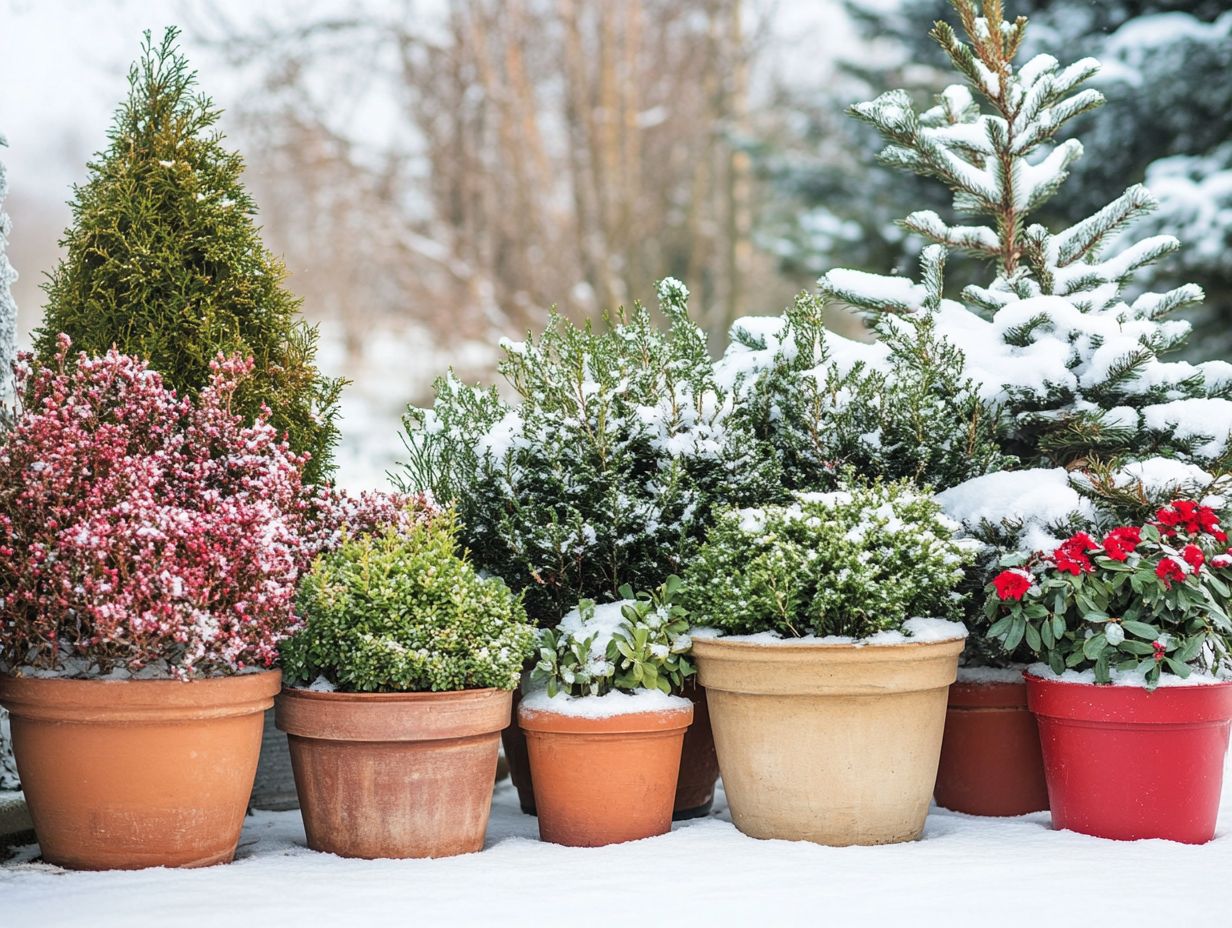
The top 10 low-maintenance plants for cold climates include junipers, boxwoods, and hollies. For those looking to protect these plants during harsh winters, the top 10 plant protectors for cold climates are perfect for your garden.
What Makes These Cold Climate Plants Suitable for Harsh Conditions?
These plants withstand harsh temperatures, frost, and snow with minimal maintenance, making them some of the top plants for fall color in cold climates. They thrive in challenging environments.
Do Cold Climate Plants Require Special Care During Winter?
These plants typically don t need special winter care. Mulching around their bases helps protect the roots from freezing.
Can These Plants Survive in Extremely Cold Temperatures?
Yes, these plants can survive even in subzero temperatures. They are hardy and resilient, making them ideal for cold climates, especially the top 5 colorful shrubs for cold climates.
Do These Plants Produce Any Flowers During Winter?
Some, like winterberries and inkberry holly, produce colorful berries during winter, adding beauty to your landscape. However, most do not bloom in winter.
Are These Cold Climate Plants Suitable for All Types of Gardens?
These plants are versatile and fit various garden styles, including formal, informal, and container gardens. For those in cold climates, the top 5 shade-tolerant plants are ideal for both residential and commercial landscapes.

